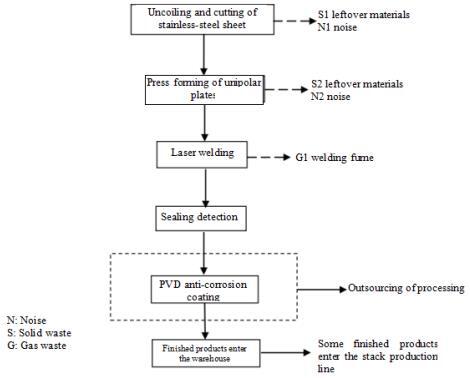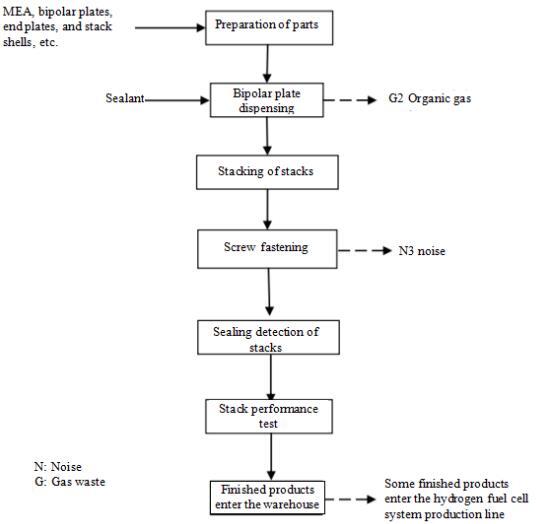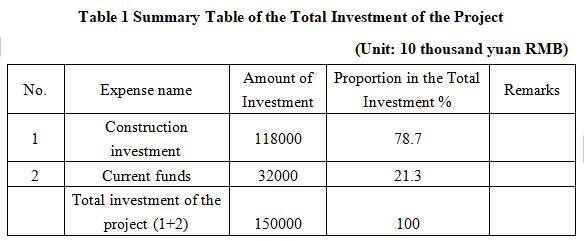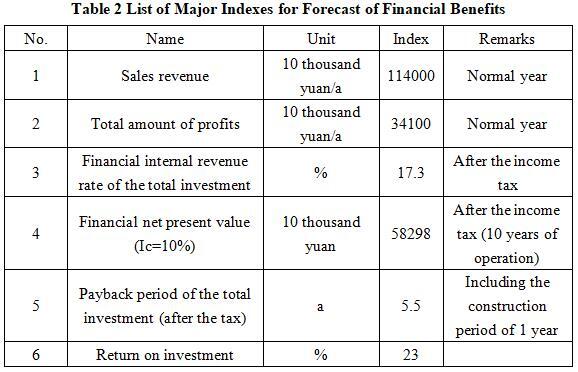Hydrogen Energy
New Energy Hydrogen Fuel Cell Industrialization Production Project of Songyuan City
1. Introduction to the Project
1.1 Project background
1.1.1 Product introduction
Hydrogen fuel cell is a power generation device that directly converts the chemical energy of hydrogen and oxygen into electrical energy. This year, with the good development momentum of hydrogen fuel cell vehicles, China’s hydrogen fuel cell industry has entered a critical period of accelerated development. Looking ahead, driven by continuous technological advancements and government policy support, the application market demand for hydrogen fuel cells is expected to steadily increase, and the industry has a very broad development prospect. This project plans to construct 9,000 sets/year of hydrogen fuel cell systems and its components, etc.
1.1.2 Market prospect
(1) Project background
Hydrogen energy, as an environment-friendly secondary energy with rich resources and wide application, is gradually becoming one of the key carriers for global energy transformation and development. In order to support the achievement of carbon peaking and carbon neutrality goals, promote revolutionary changes in energy production and consumption, build a clean, low-carbon, safe, and efficient energy system, and promote the high-quality development of the hydrogen energy industry, the National Development and Reform Commission and the National Energy Administration have jointly formulated the Medium- and Long-Term Plan for the Development of the Hydrogen Energy Industry (2021-2035). This plan provides detailed deployment of key measures to promote the high-quality development of the hydrogen energy industry, as well as phased goals for industrial development.
On a global scale, we are witnessing a tremendous transformation that has not been seen in a century. The new round of technological revolution and industrial transformation has historically intersected with the demand for high-quality economic development in China. Significant progress has been made in the development and utilization of hydrogen energy, represented by fuel cell technology, providing key solutions for achieving zero-emission energy utilization. We must firmly grasp the development trend and opportunities of global energy transformation, accelerate the cultivation of the hydrogen energy industry, and promote China’s energy transformation towards clean and low-carbon energy.
From an international perspective, major developed countries around the world attach great importance to the development of the hydrogen energy industry. Hydrogen energy has become an important strategic choice for promoting energy transformation and upgrading, as well as cultivating new economic growth points. The key core technologies of the global hydrogen energy industrial chain are maturing, the shipment volume of fuel cells is rapidly increasing, the cost is continuously decreasing, the construction of hydrogen energy infrastructure is accelerating significantly, and regional hydrogen energy supply networks are forming.
Domestically, China is the world's largest country of hydrogen production, with an annual hydrogen production of approximately 33 million tons, of which about 12 million tons meet industrial hydrogen quality standards. China’s installed capacity of renewable energy ranks first in the world, with great potential in the supply of clean and low-carbon hydrogen energy. The domestic hydrogen energy industry is showing a positive development trend, and has initially mastered the main technologies and production processes such as hydrogen energy preparation, storage and transportation, hydrogen refueling, fuel cells, and system integration. Small-scale demonstration applications of fuel cell vehicles have been achieved in some regions. There are over 300 industrial enterprises above designated size in the entire industrial chain, mainly concentrated in the Yangtze River Delta, Guangdong-Hong Kong-Macao Greater Bay Area, and Beijing-Tianjin-Hebei Region, etc.
However, overall, China’s hydrogen energy industry is still in its early stages of development. Compared with the international advanced level, China’s hydrogen energy industry still has shortcomings in innovation capability, technological equipment level, and basic institutional construction, etc. The form and path of industrial development need to be further explored. Meanwhile, problems such as blindly following the trend, homogeneous competition, and low-level construction have begun to emerge in some regions. In the face of new situations, opportunities, and challenges, it is urgent to strengthen top-level design and overall planning, enhance the innovation capability of the hydrogen energy industry, expand new areas of market application, and guide the healthy and orderly development of the industry.
The Medium and Long-term Plan for Hydrogen Energy Industry Development (2021-2035) emphasized that we should coordinate the layout of the national hydrogen energy industry, reasonably control the pace of industrial development, avoid disorderly competition, orderly promote the construction of hydrogen energy infrastructure, strengthen the safety management of hydrogen energy infrastructure, and accelerate the construction of a safe, stable, and efficient hydrogen energy supply network.
Hydrogen fuel cell is a device that converts hydrogen gas into electrical energy. According to the different electrolytes, hydrogen fuel cells are mainly divided into proton exchange membrane fuel cells, alkaline fuel cells, solid oxide fuel cells, phosphoric acid fuel cells, and molten carbonate fuel cells, etc. In the industrialization process of hydrogen energy, hydrogen fuel cells are one of the key links for the large-scale promotion and use of green hydrogen as a new energy.
Based on the above background, national policy guidelines, and the planning and standard requirements of the battery industry, it is currently an excellent opportunity to develop clean, safe, and efficient hydrogen energy. Therefore, the new energy hydrogen fuel cell industrialization production project has been proposed.
(2) The necessity of project construction
The need for the transformation of the national energy power system:
With the rapid development of China’s economy and industrialization process, energy issues have become a key factor restricting the national economy. China’s high reliance on fossil fuels, especially petroleum, poses significant challenges to its energy security. From the perspective of national security, the stability of petroleum supply is closely linked to economic development and social stability. Meanwhile, global climate change and environmental issues have highlighted the limitations of traditional energy power system. Therefore, promoting the hydrogen fuel cell industrialization production project is particularly crucial. Hydrogen fuel cell has become an important direction for future energy development due to its characteristics of being clean, efficient, and renewable. Through the construction of this project, the energy structure can be optimized, China’s influence in the global energy field can be enhanced, and China can be promoted towards becoming an energy power.
The implementation of the project is conducive to seizing industry opportunities and seizing market opportunities:
With the increasing global emphasis on environmental protection and energy transformation, the new energy vehicle market is growing rapidly. As an important branch of new energy vehicles, hydrogen fuel cell vehicles have the advantages of being clean, efficient and environment-friendly, which are in line with the global trend of electrification, intelligence, networking, and sharing in the automobile industry. The hydrogen fuel cell vehicle market has enormous potential, and governments both domestically and internationally have introduced relevant policies to support the development of hydrogen fuel cell vehicles. Constructing the new energy hydrogen fuel cell industrialization production project can help seize market opportunities and promote the commercialization process of hydrogen fuel cell vehicles.
The need for economic development in Fuyu City:
To promote the economic development in Fuyu City, taking the development of high-tech industries as a breakthrough point and the construction of industrial clusters as a platform, we should vigorously promote industrial upgrading. Keeping up with the new trend of the global industrial and technological revolution closely, we should take the development of high-tech industries as a key measure to promote strategic adjustment of economic structure. We should accelerate the pace of economic transformation, seize the commanding height of future development, promote the large-scale development of high-tech industries in Fuyu City, and quickly form a modern industrial system with rational industrial structure, scientific industrial layout, and concentrated industrial development. This project belongs to a new energy high-tech project, which is highly compatible with the measures taken by Fuyu City to vigorously develop high-tech industries.
The need for addressing employment:
Based on its production scale and labor quota standards, this project is expected to create nearly 200 new job opportunities. In addition, after the completion of the project, it will drive the development of supporting industries for super-capacitor battery components. As these industries are labor-intensive, they can also provide a large number of employment opportunities for the society. Therefore, the construction of this project will provide a large number of employment opportunities for the local area, which plays an important promotion role in alleviating current employment pressure and other aspects.
To sum up, the construction of the new energy hydrogen fuel cell industrialization production project is not only necessary but also urgent.
3 Project prospect
In recent years, the hydrogen fuel cell industry has ushered in an opportunity period of rapid development. With the adjustment of global energy structure and the popularization of clean energy, hydrogen fuel cell, as an efficient and environment-friendly energy conversion technology, is gradually becoming an important part of the new energy field. Many domestic and foreign enterprises and research institutions have invested heavily to accelerate the research and development and application of hydrogen fuel cell technology.
The hydrogen fuel cell market is showing a diversified development trend. From the perspective of application field, hydrogen fuel cells are not only widely applied in the transportation field, such as buses, taxis, and logistics vehicles, etc., but also gradually expanded to fields such as electricity, industry, and building, etc. With the continuous advancement of technology and the reduction of costs, it will become possible for hydrogen fuel cells to be applied in more fields.
From the perspective of market competition pattern, the hydrogen fuel cell industry has currently formed a relatively obvious echelon distribution. Developed countries and regions represented by the United States, Japan, and Europe are in a leading position in the research and development and industrialization of hydrogen fuel cell technology, and they have mature technology and rich experience. However, as an emerging market, China has made significant progress in the hydrogen fuel cell industry driven by policy support and market demand.
In recent years, China’s hydrogen fuel cell industry has received high attention from governments at all levels and key support from national industrial policies. China has successively introduced multiple policies to encourage the development and innovation of the hydrogen fuel cell industry. Industrial policies such as the Implementation Plan on Leading New Industries with Standardization (2023-2035), Guidelines for Establishing the Standards System on Hydrogen Energy Industry (2023 Edition), and the Medium and Long-term Plan for Hydrogen Energy Industry Development (2021-2035) have provided clear and broad market prospect for the development of the hydrogen fuel cell industry, as well as favorable production and operation environment for enterprises.
The application of hydrogen fuel cells in China has taken a leading position in commercial vehicles (especially buses and logistics vehicles), with a proportion of 94.74% in 2023. Followed by the application in fixed power generation, which includes all fuel cells that operate as main power sources (power stations), backup power sources, or combined heat and power generation at fixed locations, such as distributed power generation and waste heat power supply. In 2023, its application proportion in fixed power generation reached 2.83%. Engineering machinery and passenger vehicles are also the main downstream application scenarios of fuel cell systems, accounting for 1.23% and 1.04%, respectively.
There are various downstream utilization pathways for hydrogen energy, mainly including transportation, metallurgy, chemical and other industrial fields. Among them, the transportation field is an important breakthrough for hydrogen consumption, with promising development prospect of fuel cell vehicles. According to the China Hydrogen Alliance’s prediction, the demand for hydrogen in China will have approached 60 million tons by 2050, of which 24.58 million tons of hydrogen will be used in the transportation field, accounting for about 40%; In the industrial field, the chemical industry is currently the main hydrogen consumption scenario, while the steel and metallurgical industry may contribute to the increase in hydrogen energy consumption. It is expected that by 2050, the total hydrogen energy consumption in the steel and chemical industries will have exceeded 160 million tons of standard coal.
On the one hand, benefiting from the rapid development of fuel cell vehicles in major downstream scenarios, the global demand for hydrogen fuel cells will continue to increase. On the other hand, the grid connection of new energy power generation has caused the problem of “wind and solar energy abandonment”, providing opportunities for the development of the hydrogen storage market. With China’s continued emphasis on environmental governance and the energy crisis caused by other geopolitical crises, new energy power generation has gradually become one of the hot spots of people’s attention. There are currently many pain points in PV, wind power and other new energy power generation, such as poor regulation flexibility, strong intermittency, and high volatility. Hydrogen storage, as an emerging energy storage technology, will effectively address these pain points. In the future, the grid connection of new energy power generation will drive the development of the hydrogen fuel cell market on the demand side.
1.1.3 Technical analysis
The products of this project include hydrogen fuel cell systems, hydrogen fuel cell stacks, and metal bipolar plates. Some cell stacks and bipolar plates are used for assembly of hydrogen fuel cell systems, while others are sold as separate products.
(1) Production process flow of metal bipolar plates

(2) Technical process of stacks

(3) Production of hydrogen fuel cell system

1.1.4 Advantageous conditions of project construction
(1) Policy advantages
The project complies with relevant policy requirements such as the National 14th Five-Year Plan and 2035 Development Plan, the Opinions of the Central Committee of the Communist Party of China and the State Council on Fully, Accurately and Comprehensively Implementing the New Development Concept and Doing a Good Job in Carbon Peak and Carbon Neutrality, the Notice of the State Council on Issuing the Action Plan for Carbon Peak before 2030, the Medium- and Long-Term Plan for the Development of the Hydrogen Energy Industry (2021-2035), the 14th Five-Year Plan for Energy Development in Jilin Province, the Implementation Opinions on Supporting Green and Low Carbon Development and Promoting Carbon Peak and Carbon Neutrality, and the Implementation Plan for the “Hydrogen-powered Jilin” Action. In addition, Jilin Province has also introduced several policy measures to support the development of the hydrogen energy industry, encouraging the construction of the integrated demonstration project for renewable energy hydrogen production and green hydrogen self-consumption, and provided support in project approval, energy-saving review, and other aspects.
The Ministry of Industry and Information Technology and other departments have successively released policy documents such as the Medium - and Long-term Development Plan for the Automobile Industry and the Development Plan for the New Energy Vehicle Industry (2021-2035) (draft for comments). Among them, the Development Plan for the New Energy Vehicle Industry (2021-2035) (draft for comments) proposed the development goal that “by 2025, the competitiveness of the new energy vehicle market will have been significantly improved, and key technologies such as power batteries, drive motors, and vehicle-mounted operating systems will have made significant breakthroughs”, and proposed that we should “insist on attaching equal importance to technological innovation of both complete vehicle and components, and break through key component technologies”.
(2) Industrial advantages
Abundant natural resources: Songyuan City has abundant natural resources, especially traditional energy resources such as petroleum and natural gas, as well as abundant wind power and solar energy resources. Songyuan City belongs to a wind power III resource area and a solar energy II resource area. The total installed capacity of wind and solar energy reaches 38 million kilowatts, accounting for 33% of the total capacity throughout the province. It has a huge development space.
Industrial foundation: Songyuan City has formed a relatively completely new energy industrial chain, including wind and solar power generation and new energy equipment manufacturing industries. As of 2024, the number of new energy power generation enterprises in Songyuan City has increased to 37, the number of equipment manufacturing enterprises has reached 10, the number of hydrogen energy projects has been 10, and a complete industrial chain has been basically formed.
Technological innovation and leading enterprises: Songyuan City has actively introduced and cultivated a number of leading enterprises in the field of new energy, such as Jilin CRRC Wind Power Equipment Co., Ltd. With the support of the government, these enterprises have continuously carried out technological innovation and production capacity improvement, and have promoted the development of the entire industry.
To sum up, Songyuan City has obvious advantages in natural resources, policy support, industrial foundation, investment scale and output value, as well as technological innovation, etc., providing a solid foundation for the construction of new energy hydrogen fuel cell project.
(3) Location advantages
Fuyu City is located in the Songnen Plain, in the north of Jilin Province and the northeast of Songyuan City, and on the wash plain of the Nenjiang River and Songhua River. Fuyu City is adjacent to Dehui City, Nong’an County, and Qian Gorlos Mongol Autonomous County across the Songhua River to the south and west. It faces Zhaoyuan County in Heilongjiang Province across the Songhua River to the north, faces Shuangcheng District in Heilongjiang Province across the Lalin River to the northeast, borders Yushu City across Huitanggou to the east, and connects with Ningjiang District in Songyuan City to the west.
Fuyu City has convenient transportation with multiple railways and highways. Three railways, including the Beijing-Harbin Railway, Harbin-Dalian High-speed Railway, and Songhuajiang-Taolaizhao Railway, pass through the territory; Four national and provincial highways, including the Beijing-Harbin Expressway, the Wuchang-Horqin Right Middle Banner Expressway under planning and construction, National Highway 102, and the Tieli-Horqin Right Middle Banner Expressway, run through the entire territory; Water transportation can reach Jilin City in the upstream and connect with Harbin City and Russia in the downstream.
(4) Talent advantages
Songyuan City has established 11 industrial colleges, scientific research internship and training bases, and doctoral workstations to support rural revitalization with 7 provincial universities including Jilin University and Jilin University of Finance and Economics. These cooperations have attracted a large number of high-level talents and college graduates to come to Songyuan for scientific research, study, work, and living. It has established a “Talent Home · Project Special Class” and connected 126 industrial projects and 83 talent projects. Through the integration platform of industry and talents, it has attracted a large number of high-level talents, which can provide sufficient talent support for the project.
In terms of human resources, Fuyu City has a large number of agricultural and industrial technical talents, as well as a sound education system, which can provide sufficient technical support and talent reserves for the projects Meanwhile, Fuyu Municipal Government actively promotes various preferential policies, encourages and supports the development of enterprises, and creates a favorable investment environment for investors.
1.2 Contents and scale of project construction
The planned area is 67,500 square meters. The construction area is 54,000 square meters, including 35,000 square meters of construction area for production, 10,000 square meters of construction area for auxiliary production facilities, 9,000 square meters of construction area for office and living facilities, and 1,600 square meters of construction area for utility works.
We plan to construct 9,000 sets/year of hydrogen fuel cell systems and components, etc., including 240,000 metal bipolar plates and 3,000 sets of hydrogen fuel cell stacks.
1.3 Total investment of the project and capital raising
The total investment of the project is 1,500 million yuan, including the construction investment of 1,180 million yuan.

1.4 Financial analysis and social evaluation
1.4.1 Main financial indexes
After the project reaches the production capacity, its annual sales revenue will be 1,140 million yuan, its profit will be 341 million yuan, its investment payback period will be 5.5 years (after the tax, including the construction period of 1 year) and its return on investment will be 23%.

Note: “10 thousand yuan” in the table is in RMB
1.4.2 Social evaluation
Environmental protection: Hydrogen fuel cells only produce water during operation and do not produce pollutants such as carbon dioxide, which helps reduce greenhouse gas emissions, and promote environmental protection and sustainable development.
Energy Security: Hydrogen fuel cells use hydrogen as fuel, which can be produced through various renewable energy (e.g., solar energy and wind energy), helping to reduce reliance on traditional fossil fuels and enhance energy supply security.
Economic benefits: The advancement and promotion of hydrogen fuel cell technology can drive the development of related industrial chains, create employment opportunities, and promote economic growth. In addition, hydrogen fuel cell vehicles have relatively low operating costs, which helps to reduce the operating costs of the transportation industry.
Technological innovation and industrial upgrading: The government’s policy support and investment in technology research and development of the hydrogen fuel cell industry have promoted innovation and industrial upgrading of related technologies, and facilitated the development and application of new energy technologies.
1.5 Cooperative way
Sole proprietorship, joint venture and cooperation.
1.6 What to be invested by the foreign party
Funds, other ways can be discussed in person.
1.7 Construction site of the project
Fuyu Economic Development Zone
1.8 Progress of the project
The project proposal has been prepared
2. Introduction to the Partner
2.1 Basic information of unit
Name: Fuyu Municipal Bureau of Commerce
Address: No. 789, Chunhua Road, Fuyu City
2.2 Overview of unit
Fuyu Economic Development Zone, formerly known as Fuyu Industrial Concentration District, Fuyu Gongpengzi Industrial Concentration District, Taolaizhao Industrial Park, and Caijiagou Industrial Park, was officially integrated and promoted to become Jilin Fuyu Economic Development Zone on March 27, 2020. The development zone is located in Fuyu, Songyuan City, Jilin Province, with a planned total area of 14.78 square kilometers, including the following parts:
Fuyu Industrial Concentration District: It covers an area of 5.67 square kilometers, with the National Highway 503 as the center of its four boundaries. It extends to the edge of the built-up area of Fuyu City on the south, 200-500 meters north of north ring road on the north, the boundary between Laodangpu Village and Yaoliuhao Village in Sanchahe Town on the east, and 1,800 meters west of the Harbin-Dalian High-speed Railway on the west.
Fuyu Gongpengzi Industrial Concentration District: It covers an area of 1.38 square kilometers, and is divided into two plots. The eastern plot is centered around the National Highway 503, extending to the edge of the built-up area of Gongpengzi Town on the west, 200-350 meters south of National Highway 503 on the south, and 300-420 meters north of National Highway 503 on the north; The western plot extends to County Road 143 on the east, 570 meters south of Provincial Road 301 on the south, 200-480 meters west of County Road 143 on the west, and 1,400 meters north of Provincial Road 301 on the north.
Taolaizhao Industrial Park: It covers an area of 6.73 square kilometers, extending to Taolaizhao Town exit of Tongjiang–Sanya Highway on the west, National Highway 102 on the east, Taolaizhao-Yushu Railway on the north, and 650-1,800 meters south of Taolaizhao-Yushu Railway on the south.
Caijiagou Industrial Park: It covers an area of 1 square kilometer, extending to 600 meters east of the Beijing-Harbin Railway on the west, Huitanggou on the east, 1,200 meters north of Jidong No. 1 Road on the north, and Jidong No. 1 Road on the south.
2.3 Contact method
Contact person of the city (prefecture) where the project is located:
Contact unit: Songyuan Municipal Commerce Bureau Investment Attraction Service Center
Contact person: Yu Lili
Tel: + 86-18004388787


